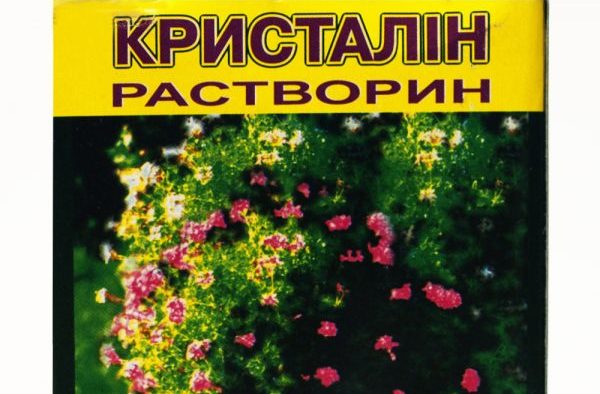Crystallin fertilizer is a worthy choice for the agrochemical industry
Content
Description
Crystallin (soluble) is completely suitable for the organization of additional in open and closed ground. Its composition is nitrogen, phosphorus and potassium. There are several brands of this fertilizer, in which there are different contents of the three main components. This is what determines its suitability for a vegetable crop, fruit tree or decorative flowers. Fertilizer labeling is indicated by the color of the package. The solution does not contain chlorine, which makes its use completely safe for the plant. Benefits of the drug:
- good nutrition of seedlings, even with a limited root space;
- rapid growth due to shock doses of nutrients;
- high efficiency with foliar feeding;
- completely dissolves in water and quickly enters the plant;
- the complex of trace elements is presented in a chelated form.
The drug is actively absorbed by both the root system and the leaf outlet. The following fertilizer brands are most commonly used:
- grade A: nitrogen 10%, potassium 20%, phosphorus 5%;
- grade A1: nitrogen 8%, potassium 28%, phosphorus 3%;
- grade B: nitrogen 18%, potassium 18%, phosphorus 0%;
- grade B1: nitrogen 16%, potassium 16%, phosphorus 0%.
All brands can be mixed with each other and used in conjunction with other agricultural chemicals.
Video "Instructions for making fertilizer"
Video instruction for making effective feeding.
Instructions for use
Application rates are determined by the type of crop and the season. In spring, when the plant is just rooting and gaining strength for growth, it is necessary to use a solution with a high nitrogen content.
With the arrival of the second summer month, it is necessary to switch to fertilizer with the lowest nitrogen content. Vegetable crops are considered the most responsive to the introduction of the substance. Fertilizer can be applied both liquid and dry.
If we are talking about vegetables in greenhouses, then the most acceptable option is the introduction of additional nutrition through watering or a sprinkler system. Depending on the conditions of agricultural technology, the concentration of the solution is 0.1-0.5%. The most optimal value is considered 0.2%, that is, the amount of solution is diluted in 1 bucket of water. Top dressing solution can be used for foliar dressing, since with this application, the plants are quickly enriched with useful substances. The additive is used to feed vegetable crops (tomatoes, cucumbers, peppers, eggplants, cabbage, greens), berries (strawberries, raspberries, currants, gooseberries, grapes), as well as for fruit trees and indoor plants.
Dosage and rates
Dosage of the preparation for root nutrition of the most popular crops:
- For tomatoes, eggplants and peppers, solution (10-15 g) is diluted in 10 liters of water. After two weeks after planting, the dose is increased to 25 g. Foliar dressing involves the use of 25 grams of crystallin per 10 liters of water during the fruiting period. The prepared solution must be sprayed on crops once a week.
- For cucumbers and zucchini - 10-15 g per 10 liters of water. The resulting substance is used to fertilize the plant when 5-6 leaves appear. Foliar nutrition is similar.
- For feeding root crops, the following algorithm is used: 10-15 g of solution is dissolved in 10 liters of water. Watering is carried out 30-40 after planting the seeds. If you take a high concentration (20-25 g), then you can do foliar feeding during the period of root crops formation.
- If we are talking about complex nutrition for fruit trees, then 1 sq.m. 10 liters of liquid is used (30-35 g of additive). Shrubs are fed per 20 g bucket of water.
As a result of the introduction of a complex water-soluble composition, a high efficiency of seed growth is achieved.
Expert Opinion Video
A plant expert's opinion on fertilization.



